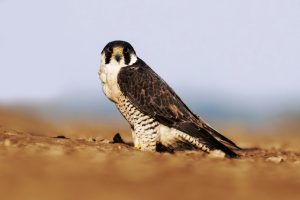The peregrine falcon stands as the fastest diving bird globally, achieving a remarkable speed of 186 miles (300 kilometers) per hour. Often referred to as a “Living Missile,” this falcon holds the title of the world’s fastest animal during its descent. The name “Peregrine Falcon” finds its origin in the Latin word “peregrinus,” signifying “foreigner” or “traveler.”
Characterized as swift and formidable predatory raptors, peregrine falcons employ strong, sharp yellow talons to seize other birds mid-flight. Their quick flight and camouflage coloring make them challenging to identify, with bluish-gray wings and tail, a darker brown back and head, occasional dark brown tear-shaped marks on the cheeks, white chin and neck, yellow-circle-surrounded eyes, and dark brown bars across the chest and wings when open. Standing at around 1.5 feet (0.4 meters) tall, these falcons boast a wingspan of 3.5 feet (one meter).
Peregrine falcons are globally distributed, inhabiting every continent except Antarctica. Displaying migratory or non-migratory behaviors, North American peregrine falcons can be found year-round in various regions, while others undertake long-distance migrations between continents from wintering to breeding grounds. Their adaptability extends to diverse habitats, encompassing mountains, forests, cities, valleys, deserts, and coastlines.

Predominantly avian carnivores, peregrine falcons prey on a wide range of species, with approximately 450 North American species documented as their prey and a potential worldwide count of 2,000. From sandhill cranes to hummingbirds, they consume various birds, along with occasional meals of bats and stolen prey from other raptors, including fish and rodents.
Nesting on cliffs, sometimes exceeding 1,300 feet in height, peregrine falcons exhibit nesting behavior along the Grand Canyon rim. Males scout multiple nest locations, with the female making the final selection. Females produce clutches of two to five eggs, which undergo incubation for 29 to 32 days. The lifespan of a peregrine falcon can reach up to 15 years, and in some cases, even longer.
This was photographed at Nalsarover, Gujarat, India.

These rare photographs have been clicked and contributed by K. Shiva Kumar, a professional Wildlife Storyteller (M.A in Journalism & Mass Communication, an alumnus of Central University Of Odisha, Koraput) from Hyderabad, Telangana.
K. Shiva, is passionate about wildlife conservation. Through his work, he hopes to inspire greater appreciation for the wildlife that shares our planet and encourages conservation action.


















